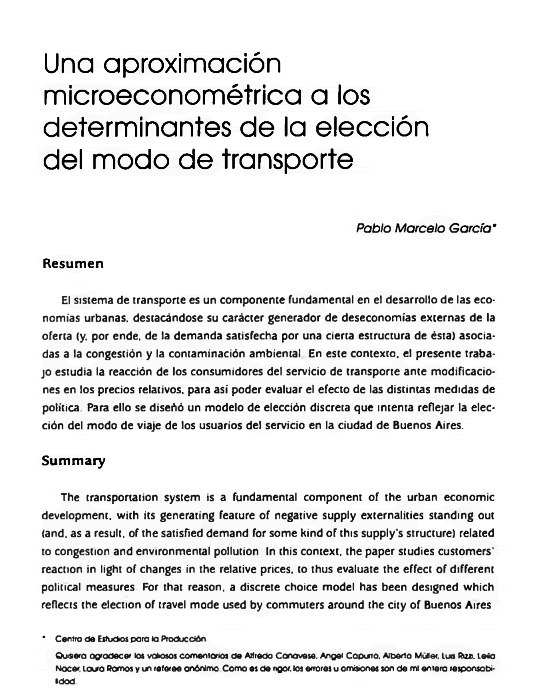A microeconometric approach to the determinants of transport mode choice
DOI:
https://doi.org/10.35319/lajed.20054266Keywords:
Microeconometrics, Urban Transportation, Urban EconomicsAbstract
The transportation system is a fundamental component of the urban economic development, with its generating feature of negative supply externalities standing out (and, as a result, of the satisfied demand for some kind of this supply’s structure) related to congestion and environmental pollution. In this context, the paper studies customers' reaction in light of changes in the relative prices, to thus evaluate the effect of different political measures. For that reason, a discrete choice model has been designed which reflects the election of travel mode used by commuters around the city of Buenos Aires.
Downloads
References
Ben-Akiva, M. y S. Lerman. 1985. Discrete Choice Analysis: Theory and Application to Travel Demand. Cambridge, Massachusetts: MIT Press.
Bunch, D. A. 1991. "Estimability in the Multinomial Probit Model". Transportation Research, B 25, 1-12.
Button, K. J. 1993. Transport economics. 2 a ed. Aldershot. Elwar Legan.
Department of Transport. 1985. Traffic Appraisal Manual. London: HMSO.
Fundación de Investigaciones Económicas Latinoamericanas (FIEL). 1995. “Financiamiento del Sector Transporte en la Región Metropolitana de Buenos Aires. Buenos Aires". Documento de Trabajo N° 49.
Garcia, P. M. 2002. “Measuring Willingness-To-Pay in Discrete Choice Models with NonParametric Techniques". Presentado en la XXXVIII Reunión Anual de la Asociación Argentina de Política Económica, realizada en noviembre de 2003.
McFadden, D. 1974. "The Measurement of Urban Travel Demand". Journal of Public Economics, Vol. 3, No. 4, 303-328.
— 1998 "Measuring Willingness-to-Pay for Transportation Improvement”. In T. Gärling, T. Lai tila, and K. Westin (eds.) Theoretical Foundations of Travel Choice Modeling, 339-364, Elsevier Science: Amsterdam.
— 2001 "Economic Choices", Nobel Lecture, December 2000. American Economic Review. Vol. 91, No. 3, 351-378, June 2001 and in Les Prix Nobel.
Manski, C. F. y S. R. Lerman. 1978. On the Use of Simulated frequencies to Approximate Choice Probabilities. Cambridge Systematic Inc.
Matzkin, R. 1991. “Semiparametric Estimation of Monotone and ConcaveUtility Functions for Polychotomous Choice Models”. Econométrica. Vol 59, 239-270.
— 1992 “Nonparametric and Distribution-Free Estimation of the Binary Threshold Crossing and the Binary Choice Models”. Econométrica. Vol 60, No. 2.
Ortúzar J. D. 1982. "Una interpretación geométrica de los modelos de elección entre alternativas discretas basados en la teoría de la utilidad aleatoria". Apuntes de Ingeniería. Pontificia Universidad Católica de Chile.
— 1994. Modelling Transport. UK.: John Wiley & Sons. Second Edition.
— 2000. Modelos econométricos de elección discreta. Pontificia Universidad Católica de Chile.
Pigou, A. 1920. The Economics of Welfare. Londres: McMillan and Co.
Scott, L. 1997. Regression Models for Categorical and Limited Dependent Variables. A volume in the Sage Series for Advanced Quantitative Techniques. Thousand Oaks, CA: Sage Publications.
Small, K. 1992. "Urban Transportation Economics”. Vol. 51 of Fundamentals of Pure and Applied Economics Series.
Villadeamigo, José. 1998. "Algunas consideraciones acerca de la politica de transporte en la Argentina”. FAI.
Willumsen, L. 1994. "Uso de preferencias declaradas para estimar el valor de la calidad de servicio". VII Congreso Latinoamericano de Transporte Público y Urbano, Buenos Aires.






